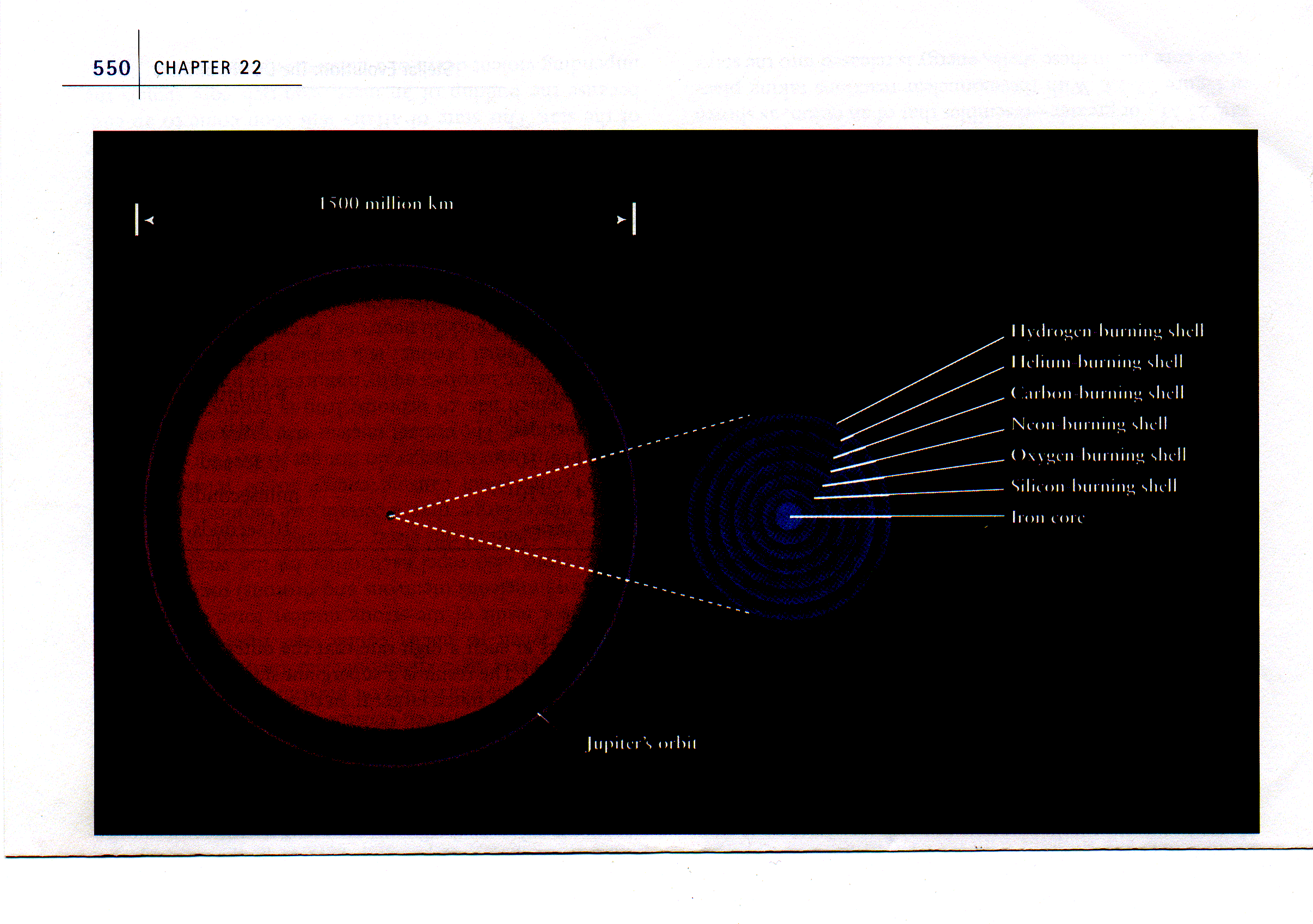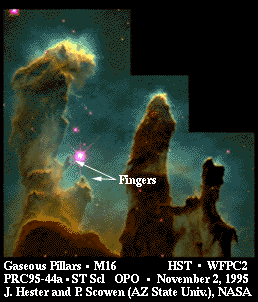SUPERNOVAE
These naturally occurring wonders
called supernovae are widely studied and observed by scientists hoping
to understand the brilliant deaths of the stellar heavyweights. In
past years these studies have been used to aid in mapping the overall shape
of the universe as well as helping to chronicle its expansion. By
studying distant supernovae, astronomers have found that the expansion
of the universe, which has been known since the 1920’s, is likely to continue
forever (NASA, 1). All stars of about 8 solar masses or less divest
most of their mass in the form of planetary nebulae. The burned out
core settles down and becomes a white dwarf star. The truly massive
stars that begin their lives with more than 8 solar masses of material
do not pass through a planetary nebula phase, instead they lose their lives
in spectacular explosions called supernovae (Kaufmann, 548). These
exploding stars are among the brightest objects in the universe, exceeding
the brightness of the sun by factors of up to 10 billion (Hogan, 1).
Due to their intrinsic brightness, they can be seen at great distances
(Hogan, 2).

* (Diagram courtesy of Kaufmann,
Universe 5th Edition)
Over recent years astronomers
have been feeling out the idea of using these magnificent exploding stars
as standard candles for cosmological and other such studies. This
new approach has been somewhat controversial, because supernovae, just
like many other stellar phenomenon, show wide variation in their properties.
By comparing the supernova’s apparent brightness (i.e. the actual observed
brightness which diminish with distance) with the supernovae’s intrinsic
brightness, astronomers can estimate their distances. By examining
the wavelength distribution of the wavelength distribution of the light
from the supernovae, astronomers can determine how fast they are receding
from us (Richmond, 2). “These two kinds of data- distances and recession
speeds of distant supernovae- allow astronomers to attempt calculation
of the rate that the universal expansion is slowing” (Spotts, 1). There
are a variety of different supernova types. Type Ia, type Ib, type
Ic and type II. Type Ia supernovae are those produced by accreting
white dwarfs in close binaries. Type II supernovae are created by
the deaths of massive stars, as are the supernova of the type Ib and Ic
which occur when the star has lost a substantial part of its outermost
layers before exploding (Gai, 1993).
 (((
(((
(Supernova 1987A, credit: NASA photo gallery)
When high mass stars are in
the later evolutionary stages, unlike a low mass star, it goes through
long sequences of thermonuclear reactions throughout its core and shells
(Irion, 6). These high-mass stars burn carbon, neon, oxygen, and
silicone. By carefully examining these high-mass stars scientists
and astronomers have found supernovae act as the foundries for most of
the chemical elements heavier than helium. The carbon in firewood,
the sulfur in a match head, the calcium in a marble, the sodium in table
salt, the iron in a bridges beams, and the oxygen that turns them red with
rust were firs forged and dispersed by ancient stellar explosions (Spotts,
1). In the final stages of its existence as a star, a high-mass body
has an iron core surrounded by concentric shells where the reaction takes
place. The reaction eventually ceases because the formation of heavier
elements than iron requires a mammoth energy input, rather than release.
The energy released during the collapse of a stars iron core comes from
gravity (NASA, 2). There is no difference between this and dropping
a brick or another object here on earth. “The brick accelerates converting
gravitational energy into energy of motion (i.e. kinetic energy) (NASA,
2). When the brick hits the ground, most of the energy of motion
goes into denting the ground and possibly, shattering the whole brick.
Some goes into heating the ground, the brick and the air. If the
brick happens to fall on your toe, you would get an immediate idea of how
much gravitational energy has been released” (NASA, 1). This is where
supernova or massive star death occurs. More than 99% of the energy
from a large supernova is emitted in the form of neutrinos from the collapsing
core (Kaufmann, 549). Obviously far more energy is released when
a 1.4 solar mass iron core collapses than when a brick falls to the earth,
because the iron cores mass and gravity are immensely greater than the
earth and the brick.

(Colliding Supernovae shells, Photo credit:
NASA photo gallery William P. Blair)
While the core of the star
is collapsing the luminosity or brightness of the star can surge to 10
producing a supernova. After this magnificent light show all the
matter thrown from the dying star flies through gaseous matter and space
dust as a nebula. Much of the universal expansion theory is still
up in the air when it comes to supernovae. Astronomers find these
distant dying stars by taking images of the sky a few weeks apart, and
then looking for changes that might be exploding stars. They use
digital light detectors that are able to count the number of photons in
each picture element precisely. They then subtract the first image
from the second and look for significant differences from zero. With
good weather astronomers confidently check thousands of galaxies in each
image pair, which will in turn show many new supernovae in the sky, if
they are to be seen (Hogan, 3).


(Web Source: observe.ivv.nasa.gov)
(Supernova remnant Kes 73, observed by the German
X-ray satellite ROSAT in March 1992)
(Photo Credit: Dr. Eric V. Gotthelf/NASA Goddard Space Flight Center)
The first example of
these beautiful explosions that we researched occurred during March 1994
in the 10th magnitude lenticular galaxy, NGC 4526. This galaxy lies
50 Million light years away on the outskirts of the Virgo cluster.
Scientists at Princeton discovered the supernova (SN 1994D) on an image
taken March 7, 1994 as a part of the Leuschner Observatory Supernova Search.
This particular star rose to a magnitude 11.8 by late March and then started
to fade by late April (Richmond, 2). Spectral observations made by
other scientists showed the supernova to be of the type IA class, which
happens when a white dwarf explodes after gaining too much mass from devouring
a neighboring star (Richmond, 2). Astronomers are constantly waiting
and watching for the next supernova, so they may witness a single star
that shines with the brightness of one-billion. The bottom line:
we live in a universe that will be expanding forever an whose basic building
blocks, namely, clusters of galaxies, will in due time disperse to infinity
(NASA, 1).

 (((
(((


